The Grizzlies
Can the Core Four take it up a notch?
Last year’s Grizzlies were the best or second-best team in the NBA for most of the season, before a collapse down the stretch lost them the Southwest Division title and landed them in the fifth seed in the playoffs. Marc Gasol had a career year, Zach Randolph had the best season since his 2012 knee injury, Mike Conley elevated his play offensively, and until the Griz fell apart and then limped into the playoffs with key injuries to Conley and Tony Allen (not to mention the broken face Conley suffered in the first round against Portland), it looked like last year was “the year.”
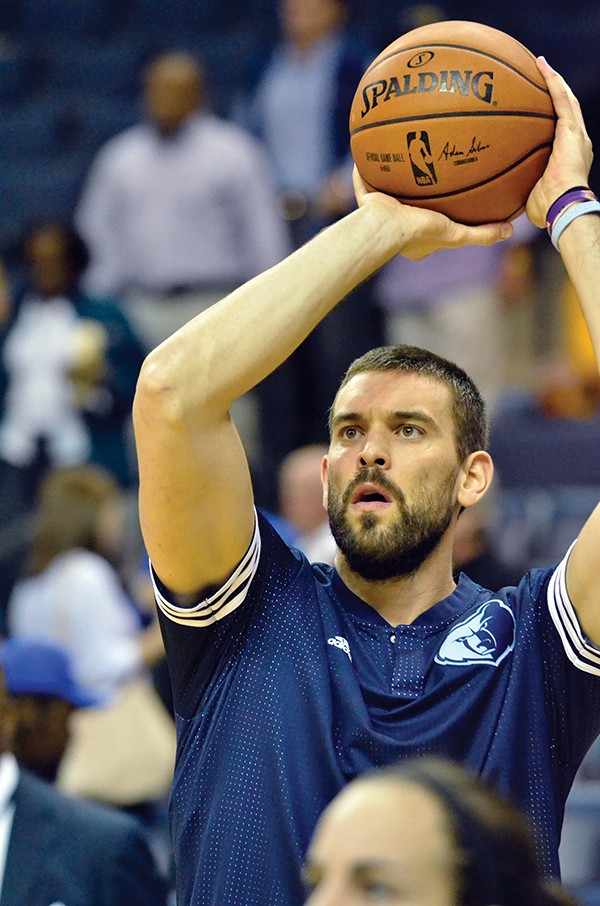 Larry Kuzniewski
Larry Kuzniewski
Marc Gasol
Instead, they took the Golden State Warriors to six games in the second round before being eliminated, and what looked like “the year” became another run at the title that didn’t quite get there.
This year, things are in flux a little bit. Here are the 10 biggest questions facing the Grizzlies in the 2015-16 season:
Can the Grizzlies really win a championship in today’s NBA?
This question has hounded the Grizzlies since they lost to the Spurs in the Conference Finals a few years back, and has only intensified in the years since, with the rise of the Warriors and Hawks and other “pace-and-space” three-point shooting teams, and of “small-ball” lineups that push the pace without traditional big men.
Given the Grizzlies’ offensive limitations, it’s not hard to see that in the postseason, when the game slows down and becomes much more chess-like and concerned with tactical adjustments made on a nightly basis, the Griz are uniquely built to be hard to adjust to, given that what’s different about them is their personnel and not the plays they run. But, as we saw in last year’s second-round series against Golden State, those limitations can become a liability in the playoffs, when the other team decides to take away the ability to score in the post and dares the Griz to shoot long-jumpers.
I’m not sure what they can do to counter those adjustments, besides have a different roster and play a different way. And with Gasol returning on a five-year deal, and Conley likely to do the same, it seems exceedingly unlikely that that’s what’s going to happen. In the meantime, we watch and wait to see if they can evolve offensively enough to turn the corner.
Is the season a failure if the Griz don’t make it past the second round?
One thing was repeated in almost every Grizzlies preview story written in national media this year: As good as these Grizzlies have been, and for as long as they’ve been that way, we still don’t know whether they’re good enough to win an NBA title. The question remains: Are the Grizzlies just going to be the speed bump in the path of the great teams forever, like the Bad Boy Pistons to the Western Conference elite’s Jordan Bulls?
This year’s team is basically the same as last year’s, with a different look from the bench (bringing in Brandan Wright and Matt Barnes has totally changed the complexion of the second unit) and a brewing controversy about whether Jeff Green or Allen should start at small forward (hint: not Green).
Now that “Can they go the distance?” is the question most often asked about the Grizzlies, instead of “Can they make the playoffs?” it’s hard to argue that it’s anything less than a disappointment every year that they don’t make a deep run into the postseason.
Is this year actually a stealth rebuild?
The conventional wisdom is that with Gasol’s return on a five-year contract, the Grizzlies are essentially “running it back” this year with the same guys, and rolling the dice to see if they can end up with better seeding and better matchups in the playoffs, thus making it to the Conference Finals or maybe even the Finals.
On paper, it looks like that’s exactly what’s happening, but I’m not so sure. Yes, the personnel is mostly unchanged from last year, but, while adding Wright to the bench is a huge deal for what the Griz can do offensively, outside the “Core Four,” the team is mostly made up of young guys who haven’t proven themselves, veterans in contract years, and old guys on the verge of retirement (Okay, maybe that’s just Vince Carter).
Is this really a stealth rebuild with a bunch of roster churn where the Grizzlies try to stay good while flipping pieces around and loading up for next year?
Let’s think through this “stealth rebuild” hypothesis. Obviously, the Grizzlies have been an excellent team for the last five straight seasons. That has to end at some point.With Randolph entering the season at age 34, and Allen turning 34 in January, it’s obvious that age will catch up with these two guys at some point. Who are the guys who are going to step up if it happens to be this year? (Crickets)
Exactly. Those guys aren’t on the roster right now. There was talk of Jarnell Stokes being “Z-Bo replacement” material, but that was a stretch at best. Right now, the Grizzlies don’t have a backup plan. The way to have a backup plan is to build your next core group while your current core group is still playing. The Spurs did this right around the time that some team from Memphis knocked them out in the first round, and came out of it with future Finals MVP Kawhi Leonard. They looked completely done in that series, but all the while some of the pieces that would win them their next championship were already on the roster.
The Grizzlies don’t have that right now. They’ve got a bunch of guys who could be that but haven’t played much, and they’ve got some guys who are probably going to be gone after this year, and then they’ve got the Core Four and Wright.
This team has a lot of expiring contracts and decisions to make this summer. Players who are free agents after this season: Conley, Green, Courtney Lee, Beno Udrih, and Barnes.
And these are the players who have team options after this year, meaning the team can decide whether to pick up that option: Jordan Adams, Stokes, Russ Smith, JaMychal Green. Carter’s final year of his contract is $4.2 million on paper but is only partially guaranteed, meaning they don’t have to pay him the whole thing if he’s waived. All nine of these guys are basically going to have to prove their worth this season (except Conley, one assumes).
I’ve said all this and it makes it sound like I think the team is going to win 30 games. I don’t believe that. I think, as good as this group of players is, health is the only thing that could keep them out of the postseason. But I do think we’re going to see the start of that roster churn this year. I think guys are going to get traded. I think they’re going to struggle to get it together because there are some interesting depth issues and some real crowds at the forward positions. I think the organization’s eyes are probably on being as good as they can this year while trying to build the next great Grizzlies team around Gasol and Conley.
If Jordan Adams gets healthy, is he going to matter this season?
Adams has the unenviable position of being a late first-round pick on a veteran team that can’t afford to “miss” on many first-round picks because most of them have been leveraged to build the current core of players.
With any luck, Coach Dave Joerger will realize at some point this season that he simply has to play Adams for the good of the team: If they’re going to develop him into a rotation player, he has to play NBA minutes. It’s the same problem former Coach Lionel Hollins had of not developing talent and then blaming the younger players for their own lack of development. I’m not encouraged that Adams will be given a chance to make a difference, but I hope he will, because the Grizzlies simply can’t afford for him not to; they’ve given up too many future draft picks already.
 Larry Kuzniewski
Larry Kuzniewski
Mike Conley
Can Mike Conley make it to April without health issues?
Even before he got his face broken in the Portland series last year, Conley was already so banged up he could barely play. He and Allen both went into the postseason with nagging injuries, the kind that don’t heal unless you take time off, and the first round of the playoffs is not the time for that.
So can Conley keep his body together long enough to make it to the playoffs intact? That depends on whether the Grizzlies’ current backup point-guard tandem of Udrih and Smith can play well enough so that Conley doesn’t have to be on the floor for more than 35 minutes a night.
Udrih isn’t really in game-shape after offseason ankle surgery, and Smith is young and unproven, just as likely to turn the ball over as he is to dazzle the crowd. And if they can actually hold down the fort, will Joerger take the opportunity to rest Conley or play him so that the Grizzlies have a better shot of winning regular-season games? If the Grizzlies are going to emulate the Spurs model, resting players and not worrying about every regular-season game is something they’re going to have to do.
Is this the year Tony Allen gets old?
Allen turns 34 this season, and his maniacal defense is greatly dependent on his athletic abilities and using his incredible physical gifts to be in the right place at the right time. But his quickness and reflexes are going to leave him at some point. He won’t always be able to play the game the way he plays it now.
Injuries have plagued Allen the last couple of years. He only played in 63 games last year, and the year before that he played 55. If that’s the beginning of a pattern, the Griz shouldn’t be surprised if Allen misses 20-plus games again this year.
I think Allen’s got another season or two left before he starts to really feel the effects of age, but his recent injury history is worrying, especially, because as far as I know, there’s not a backup plan for losing one of the league’s best perimeter defenders.
Jeff Green’s not really a starter, is he?
I’m withholding judgment on the Green Starting at Small Forward era until I have more than one game’s worth of evidence on which to base said judgment, but that first game was just like the preseason, and just like the games last year where it happened: The offense reverted to the bad old days of the Lionel Hollins/Rudy Gay Memorial Clogged Toilet Offense — nobody moved and guys dribbled the ball until somebody came open for a quick shot instead of passing the ball around.
I don’t think it’s a coincidence that the presence of a player similar to Gay in the lineup has brought back the same issues that plagued this roster when Gay was here. But maybe Green just hasn’t found his rhythm yet. Maybe he needs a few games to get his sea legs.
Who will be on the roster after the trade deadline?
I’m sure that if the Jeff Green experiment has proven by February that it’s not going to work out, Green will be shopped (he’s got a $9 million expiring contract). Other guys with expiring contracts might be too, though if Lee can keep up his hot streak of aggressive play from the preseason, he won’t be going anywhere and will probably get re-signed to the Grizzlies to a new deal. Time, and Lee’s production, will tell.
Is this the year people stop saying they want Lionel Hollins to be coach again?
Judging from Twitter during the Grizzlies’ blowout loss to the Cavs to open the season, not even close. — Kevin Lipe
The Tigers
Can the Tigers turn the program — and Josh Pastner’s career — around?
These are sunny days for the University of Memphis — if you’re a football fan. But what of the long-proud basketball program, last seen leaving a court in Hartford, Connecticut, an 18-14 season in the books, and no postseason tournament for the first time in 15 years? The questions abound.
Should Memphis coach Josh Pastner take the departures of Austin Nichols and Nick King personally?
Yes and no. Anytime a still-valued player leaves a program (read: coach), exhaust fumes from the proverbial getaway car surround the coach with an unmistakable stench, at least for a while.
 Larry Kuzniewski
Larry Kuzniewski
Josh Pastner
King and Nichols were Pastner’s prize catches in the recruiting class that arrived merely two years ago. Furthermore, they are products of this city, raised on blue dreams and gray passions. For each player to decide — after but two seasons — that the hometown program (read: coach) is not a good fit is quite the opposite of a selling point for future prize recruits, be they from Memphis or elsewhere.
“I was totally blindsided by Austin Nichols,” Pastner says. “Had no idea. I’d had many conversations with him. He told me he loved it here. That said, there’s no ill will. We move forward.We’ll play differently, spread the floor more.”
But then also consider the departures, in modern terms, business decisions. King was a disappointing player over his two seasons with Memphis. A new environment and uniform can make for a fresh start in ways that more subtle adjustments (goal-setting, work habits, etc.) cannot. And Nichols clearly had one eye on Virginia since his days at Briarcrest. Memphis (read: Pastner) obviously didn’t provide enough to refocus that wandering eye, but this is a divorce initiated by the player, not the coach. The Tigers will not win without players who want to play for Memphis.
Can Shaq Goodwin (finally) be The Man?
The Tigers’ senior power forward has had a nice college career. In 101 games with Memphis (91 of them starts), Goodwin has averaged 9.5 points and 6.0 rebounds. (As a junior last season, the numbers were 9.6 and 7.1.) With 44 more points, Goodwin will become the 50th member of the program’s 1,000-point club. If he stays healthy, the Georgia native will likely climb to ninth in career rebounds at the U of M. But …
There always seems to be a “but” in measuring Goodwin’s impact. He was positively monstrous (23 rebounds) in a one-point loss to Temple at FedExForum last February. But he took only eight shots (and made only two), coming up short on the offensive end in a game the Tigers had to win (and lost by a single point). Goodwin must be a complete force — the face and body of this program — for the Tigers to have any hope of NCAA tournament play come March.
What are we to make of the Tigers’ backcourt?
Lots of pieces here, few of them guaranteed playing-time. There are a pair of seniors with SEC experience (Kedren Johnson and Ricky Tarrant). There are two familiar faces whose roles never became clear last season (Avery Woodson and Markel Crawford). There’s a trio of freshmen who could land rotation spots or end up waving towels at the end of the bench (Jeremiah Martin, Randall Broddie, and Craig Randall).
If Pastner fails to clearly identify and assign roles, the backcourt could become a mess. Try winning a basketball game when you don’t know who is handling the ball.
“[Tarrant] is a veteran guard,” Pastner emphasizes. “He can score; he knows how to play. When he wants to be a very good defender, he can be.” Tarrant is well-traveled, having scored 1,000 points at Tulane (where he was C-USA’s Freshman of the Year in 2012) and last season at Alabama before transferring as a graduate student to Memphis. He would seem to be a stabilizer for an otherwise young roster, a player who won’t be surprised by the size and speed of Division I college basketball.
“I’m excited to see how we play with better spacing,” Pastner says. “And we’ll play faster. We need to do some things better than we did last year. We had a lot of turnovers to start the season and gave away games. Our guard play wasn’t good enough, and that falls on me. I made some recruiting misjudgments.”
Johnson has been dealing with a balky right shoulder, and Tarrant is coming off foot surgery, so this bounty of guards may be reduced — temporarily or long-term — when the Tigers open against Southern Miss on November 14th.
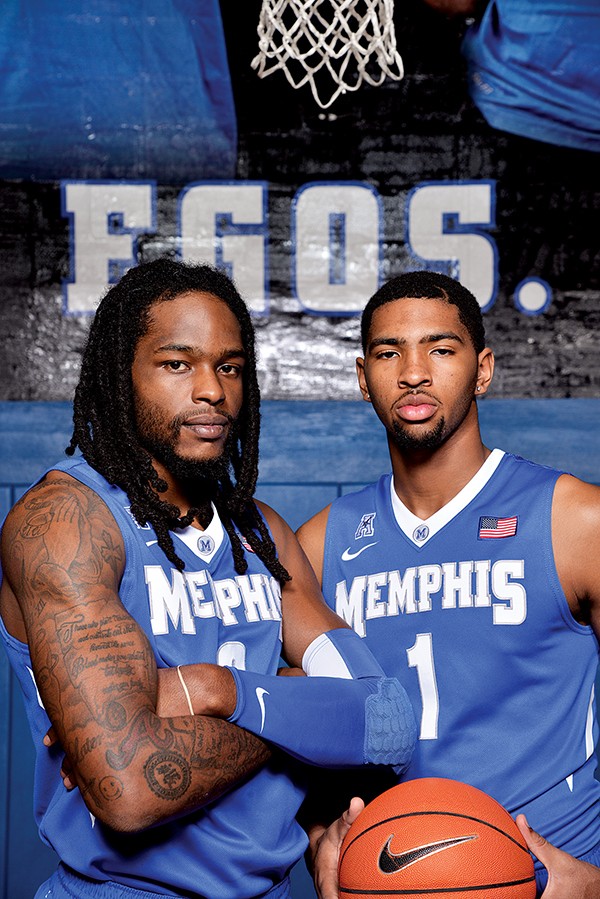 Larry Kuzniewski
Larry Kuzniewski
Shaq Goodwin and Dedric Lawson
What can be expected from star recruit Dedric Lawson?
Memphis has seen mixed results from the last four McDonald’s All-Americans to suit up as Tigers. None of them — Elliot Williams, Joe Jackson, Adonis Thomas, and Goodwin — reached the Sweet 16 of the NCAA tournament. (Goodwin, of course, has one more season to change this.) Lawson turned 18 on October 1st. Can he compete immediately against players four and five years older?
“He’s a high-IQ and skill guy who can shoot the ball,” Pastner says. “He can create matchup problems. We’re asking him to do a lot from the get-go.” Having his older brother, K.J., nearby could ease the transition to college life for Dedric. “There’s a comfort level,” Pastner says, “and they’ve had success together, both in high school and AAU ball.” (Having one’s father on the bench, on the other hand, can be a mixed blessing. We’ll see what kind of influence Keelon has this year with two of his sons fighting for playing time.)
Does this team have a good shooter?
Woodson (37.7 percent) and Johnson (35. 3 percent) were competent but inconsistent from the outside last season. Tarrant (29.9 percent) won’t make anyone forget Doneal Mack, let alone Rodney Carney. Newcomers Broddie and Randall know their way to the basket, but neither will be a high-volume scorer from long distance. Former Mitchell High School star Jeremiah Martin — in the mix at point guard — shot 37 percent from three-point range as a senior and could build his value in the rotation as an off-the-bench shooter. “He plays hard,” Pastner says. “We’re teaching him some things. He has a tendency in transition to gamble. You can get away with that in high school.”
Pastner thinks his team needs to be more efficient from the three-point range. “The adjustments we make, spacing-wise, will allow more time for shooters to set their feet,” he says. “We’ll get open looks with better spacing.”
Are the Tigers too small?
The Tigers have exactly three players taller than 6’7″: Goodwin and Dedric Lawson are each 6’9″ (and must avoid foul trouble like processed meat), and Marshall is 6’11”. A native of Lexington, Tennessee, Marshall will likely absorb much of the blue-collar responsibilities: shot-blocking, offensive rebounds, defense help. “He’ll have some highs and lows as a freshman,” Pastner says. “He runs hard, rebounds hard. He’s not really skilled offensively right now. But his effort’s there. In time, he’ll be really good for us.”
 Larry Kuzniewski
Larry Kuzniewski
Shaq Goodwin
Goodwin loves what he’s seen from Marshall. “He’s my favorite,” the senior says. “He’s big. So much opportunity. He’s smart, too. And he’s got a soft touch around the bucket; he’s just a little raw.” The Tigers are a small team. Pay close attention to Marshall’s development.
Who is the Tigers’ X factor?
Trahson Burrell. The senior swingman displayed versatility on the wing (and on both ends of the floor) that called to mind former star Will Barton, but with the frequency of a moon phase. Six straight games with at least 10 points last December (five of them Tiger wins). Six straight games in single figures last February (three Memphis wins).
“He has to be a better defender for us,” Pastner says. Even with a season under his belt, Burrell may have the biggest “upside” of any player on the Memphis roster. And this team needs him … way up.
Can the Tigers win the AAC?
The American Athletic Conference sent two teams to the NCAA tournament last March. Defending league champ SMU has been banned from postseason play (and its Hall of Fame coach, Larry Brown, suspended nine games) for NCAA infractions. Cincinnati is a perennial threat, but a team Memphis beat by 13 last winter. The transitional nature of modern college basketball makes it hard to forecast a team’s strength based on the previous season. AAC coaches picked Memphis to finish fifth in the league, behind SMU, UConn, Cincinnati, and Tulsa, so these Tigers will play as underdogs.
What’s the most important area of improvement for the Tigers this season?
Count the empty seats at FedExForum. Last winter, there were an alarming number. If more of them aren’t filled this season, you’ll know the program is heading in the wrong direction. As recently as 2010-11 (Pastner’s second season as head coach), the Tigers averaged 16,768 tickets sold on game night. Last season, that figure plummeted to 13,915 (still 21st in the country).
For the second season in a row, Memphis will pack December with seven home games. The opponents are not the kind you circle a date to see: Louisiana Tech, Southeast Missouri, Manhattan, Southern, Ole Miss (okay, one circle), IUPUI, Tulane.
If the Tigers were in the Top 10 and bursting with star power on the court, you might see 16,000 fans visit FedExForum on a December Tuesday with Southern in town. The 2015-16 Tigers will be fortunate if 10,000 show up.
Will this be Pastner’s final season with the Tigers?
If the Tigers win 25 games and reach the second week of the NCAA tournament, Pastner will not just return; he’ll likely get a raise and an extension (beyond his current contract, which has him here through the 2017-18 season). If the Tigers fail to reach the NCAAs for a second year in a row, it’s hard to imagine Pastner surviving the outcry. The U of M fan base can go negative in the best of times. (Remember John Calipari’s “Miserables”?)
The Tiger coach remains positive. Reflecting on significant players’ transfers, Pastner notes, “Everything was basketball-related. We’re in Memphis, and you’re under a microscope 365 days a year. We’re privileged to have that microscope. The offseason had its challenges, but it was nothing that embarrassed the university or was against the law.”
Pastner thinks the number of televised games has contributed to the lower attendance figures, and on-court struggles have been exacerbated by that metaphorical media microscope. “There’s a lot of negativity by some media members,” he says. “Maybe they don’t like me. Maybe they don’t like me because I’m positive and they choose to live their lives negatively. I think it gets overblown. I’m gonna stay positive, locked in on who I am.
“When you step back and look at the success we’ve had here over six years [148 wins, 58 losses], a lot of people would have signed up for that. I love my job, and I love Memphis. I hope to be here a long time.”
Count at least one significant player fully in Pastner’s camp. “It took me a while to understand it,” Goodwin says. “But that’s how he is, 100 percent of the time. You can think of things — anything in life — two different ways: positive or negative. So why negative? I took it and ran with it. I preach it to the team. Last year, when I was struggling, I looked at things in a negative light. Had to change my mindset.”
Wins have historically been the best mindset-booster in sports. For this team, its coach, and fan base, a season of revelation is upon us. — Frank Murtaugh
 Greg Cravens
Greg Cravens  Larry Kuzniewski
Larry Kuzniewski  Larry Kuzniewski
Larry Kuzniewski  Larry Kuzniewski
Larry Kuzniewski 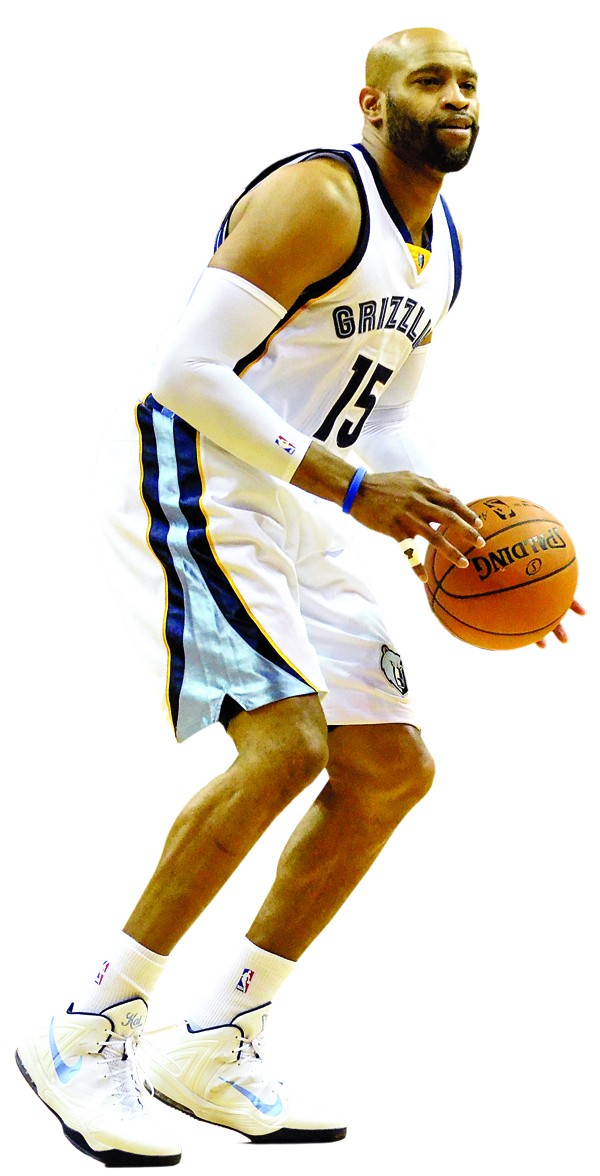 Larry Kuzniewski
Larry Kuzniewski 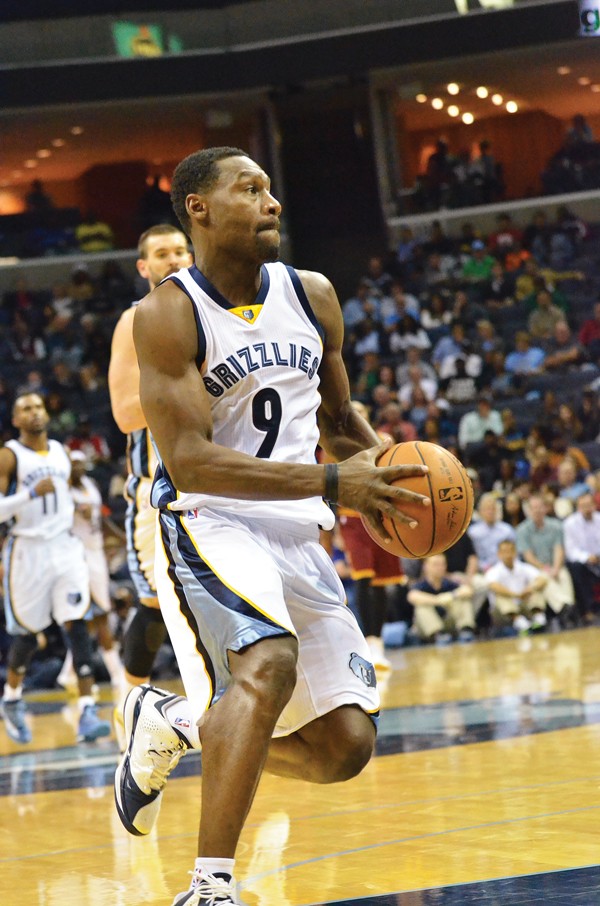 Larry Kuzniewski
Larry Kuzniewski 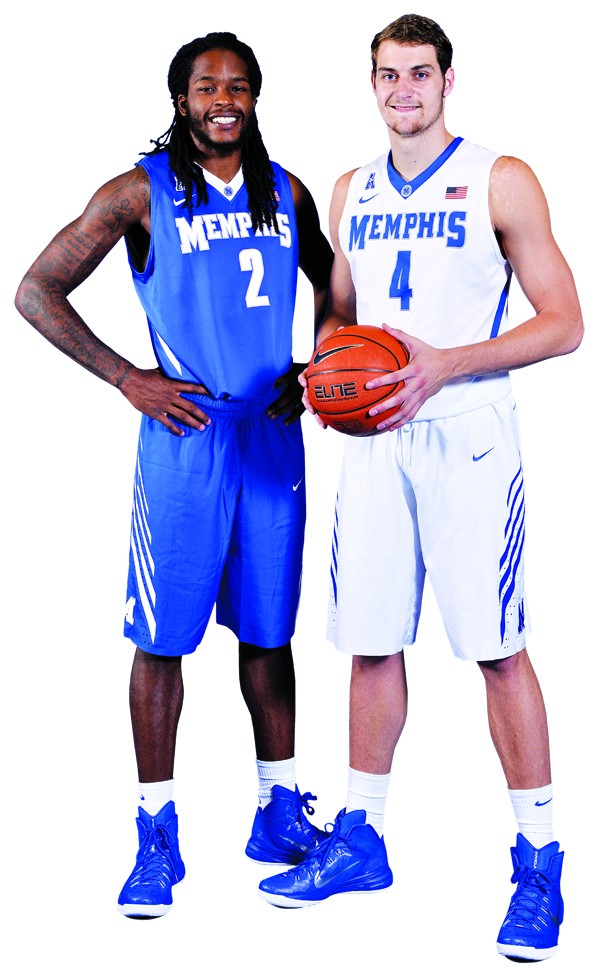 Larry Kuzniewski
Larry Kuzniewski  Larry Kuzniewski
Larry Kuzniewski